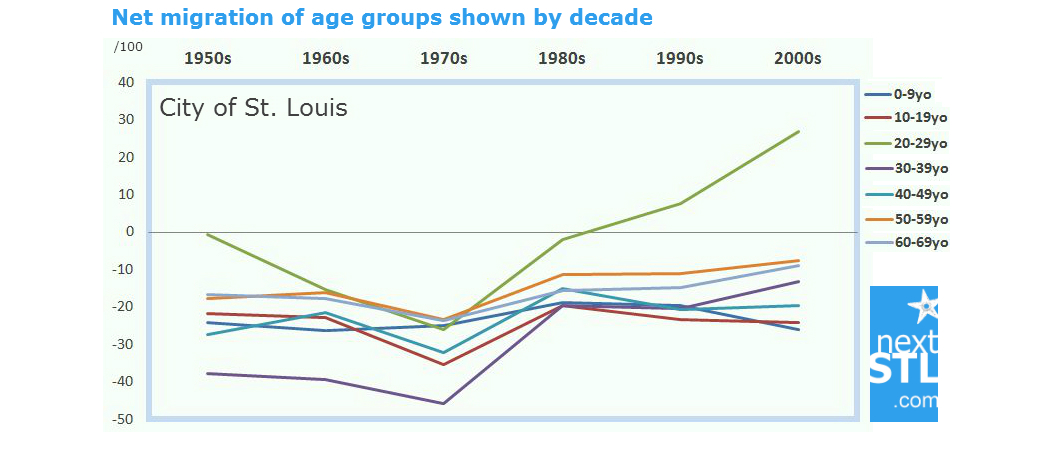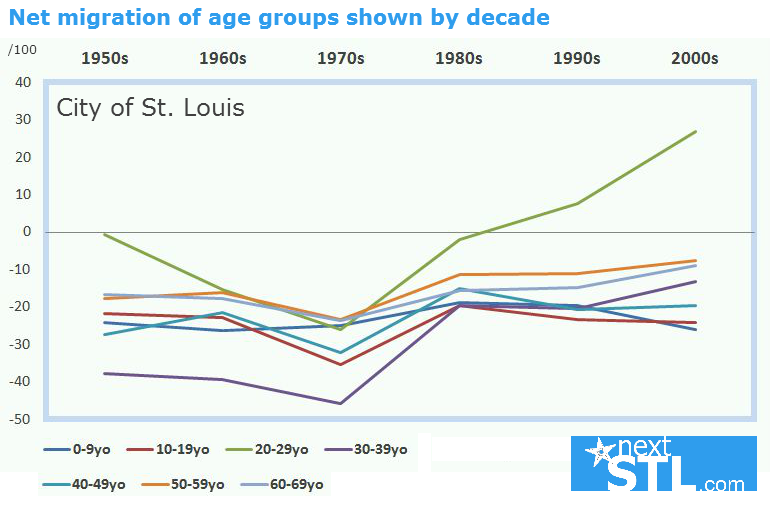
The Millennials are coming! The Millennials are coming! For St. Louis, some seem unsure whether Paul Revere or Chicken Little is the messenger. This past decade, 20 to 34 year-olds moved into the City of St. Louis at a higher rate than at any time in the past half century, by far. The Millennial generation, those born in the early 1980s to 2000, are credited with revitalizing urban neighborhoods across the nation. They’re also mocked for wearing tight jeans, riding steel bicycles, and enjoying craft beer. But only the willfully ignorant or those preening on the journalistic crutch of self-righteous certainty bestowed upon them by decades of the same, can deny the massive and unprecedented demographic shift that is remaking our inner cities.
In the 1970s, net migration of 20-24 year-olds in the City of St. Louis was -24.1/100. Those who stayed kept the city from turning out the lights. The revitalization of Soulard and Lafayette Square got started that decade. We may owe the existence of those neighborhoods to those individuals. Yet many more neighborhoods fell. Young people were fleeing the city. In fact, every age group was fleeing St. Louis in the 1970s. The city lost a net 169,435 residents that decade, 27.2% of its population. So yes, thank you for painting that Victorian on Mississippi, but your generation hated the city. Oh, and every age group saw a negative net migration in the 1960s and the 1980s too.
The city was dying. Cities don’t die when some people leave, some groups have always left, but when everyone’s leaving, cities die. Then in the 1990s, people aged 20-29 produced the first positive net migration for any group since the 1950s. These are the GenXers. And oh my God, just wait until some blinkered editorial key pecker is told that GenX deserves credit for resuscitating St. Louis and other American cities. Net migration for 25-29 year-olds has rocketed from -28.1/100 in the 1970s, to 11.8/100 in the 1990s, to 35/100 in the 2000s. This is an unprecedented demographic shift in our city
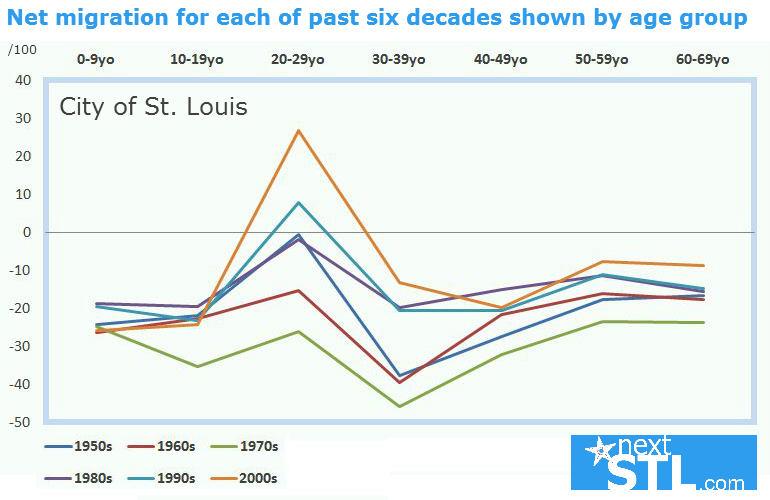
Sure, there have always been urban pioneers. In St. Louis, this young adult group spans from Pierre Laclede to Stephanie, the 20-something entrepreneur who just ordered an Indonesian Tana Toraja pour over on South Jefferson. It’s notable, but not remarkable, that this cohort has nearly always accounted for a disproportionate share of city growth. The difference is that the current iteration of this group is moving into the City of St. Louis and other urban centers in numbers not seen in a century, maybe longer.
The coffeehouses and dog parks are the superficial markers someone unwilling or unable to use empirical data, or unaware of larger cultural shifts, uses to apply a veneer of sameness over the real change. Some conclude that this new generation of self-aggrandizing, self-appointed city-savers haven’t earned anything, that their pompous self-importance is nothing new. This is false. No single generation “saves” a city, but Millennials are having a greater positive impact on the population of the City of St. Louis than any generation in several generations. And yet it’s apparently more comfortable to offer a rhetorical ear flip to a new generation than recognize how the world is changing around you.
Late last year the Millennial effect on Baltimore City received some positive press. The source of the good news and optimism was a project produced by The Applied Population Laboratory at the University of Wisconsin. What it showed was a massive increase in the net migration rate for 19-29 year olds. This was a welcome change, and seen as further proof of the Millennial preference for urban living. The rate for the 20-24-year-old cohort tripled. The 25-29 cohort exploded from a -1.9/100 net migration in the 1990’s to a +27.2/100 in the 2000s.
For those willing to acknowledge the above, the rejoinder is often a sharp, “but will they stay?” Well of course they won’t stay. In this past American century younger generations have always left our older central cities as they age. Until the 1990s, 20-29 year olds in the City of St. Louis were leaving. Those GenXers who delivered the first positive net migration numbers for the city are now at -13.15/100 net migration as 30-39 year olds, the lowest negative net number in the past 60 years for that age group. Today, 50-59 and 60-69 year olds are also at their lowest negative net number since at least 1950, at -7.7 and -8.85/100 respectively.
The Millennials, as they age, will not keep coming to the City of St. Louis in the numbers they are now. But if the past 30 years serve as a guide, more will stay than past generations. The key for St. Louis is to continue to be a magnet for 20-somethings. The real question doesn’t appear to be how many will leave, but rather how many more can the city attract? They’re going to leave, and likely in large numbers, but virtually no comparable city, nor cities St. Louis may aspire to emulate, has been able to stop this trend. When looking across the experience of American cities since 1950, residents aged 0-14 and 35-75+ have left urban centers everywhere. This is true of the older industrial cities such as Pittsburgh, Cleveland, Cincinnati, Chicago, Philadelphia, and Baltimore, but also Boston, San Francisco, and Denver.
Boston has gained population each of the past three decades. The only positive net migration has come from 15-29 year olds over that period. Every other age group has left the city in greater numbers than it has arrived. Philadelphia’s population has remained relatively stable since 1980 (~-8%). That city only saw positive net migration from 20-29 year olds in the 80s and 90s and 15-29 year olds in the 00s. So how does St. Louis compare across age groups?
In the 2000s, the City of St. Louis outperformed Suffolk County, MA (Boston) in net migration of 30-74 year olds. That would seem incredible. St. Louis is holding onto this age group at a higher rate than Boston. This past decade, St. Louis had virtually identical net migration numbers for 35-74 year olds as San Francisco. And yet, the City of St. Louis is neither Boston, nor San Francisco. Numbers in Denver and Washington D.C. follow a similar pattern. In the 2000s, the net migration for 20-24 year olds in Boston was 150.5/100 and in San Francisco, 101.1/100. While the St. Louis number was a positive number, it was just 18.7/100. For 25-29 year olds: Boston = 75/100, San Francisco = 172.9/100, St. Louis = 35/100. That is, Boston attracted 20-29 year olds at four times and San Francisco at five times the rate of St. Louis
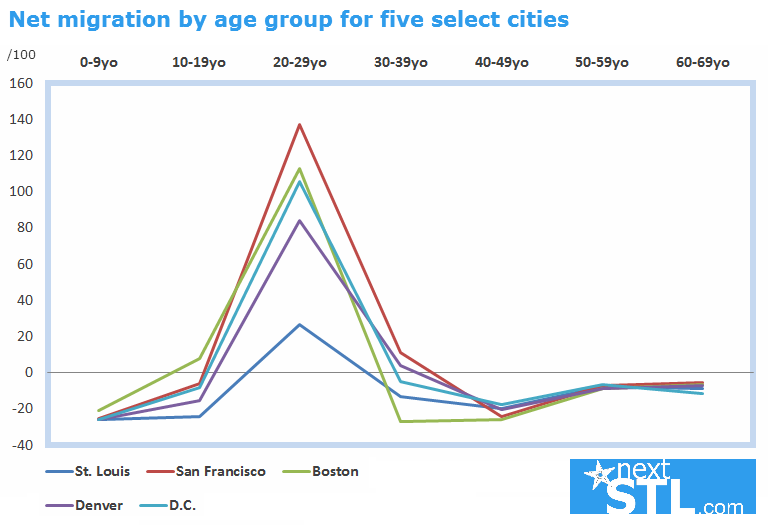
Millennials are changing St. Louis in numbers no other generation of the past half century has matched. But if the city wants to be a technology hub, wants to be an entrepreneurial center, a smart city, a vibrant city, an economically healthy city, it will need more of them, and more of the next generation, and the generation after that. The higher the peak of in-migration for the 20-29 year old cohort, the larger the impact in future years.
These are the numbers and trends. They’re real. What the numbers do not, and can not, do is assign causes to why generational numbers have shifted so dramatically in American cities, including St. Louis. Has the decline in urban crime made cities more inviting? Did public policy such as denial of mortgage insurance for large swaths of cities and highway expansion push past generations to leave? Have historic buildings and their renovation attracted new residents? Are education options improving? Or is it a broad societal shift that places less value on the relative seclusion and tranquility of the suburbs? Is it extended adolescence and putting off marriage and children?
Of course a city would like to retain more people of all ages and so an all-of-the-above approach is necessary, but if you think Millennials are just the latest in self-proclaimed urban savoirs, you couldn’t be more wrong. Whether we’re blind to this, or aware of and understand its impact, will help determine the future of St. Louis. Before a mayor is criticized for courting young people (Meanwhile City of St. Louis Mayor Francis Slay has been re-elected several times by dominating the over 55 vote. And while we’re at it, there’s no evidence that calls for snow service came from the ironic mustachioed vegans more than any other group in the city.), the revolutionary change in city demographics must be admitted.
The difference between St. Louis and places like San Francisco, Denver, D.C., and Boston isn’t that we’re losing families with young children, 40-somethings, or empty nesters, it’s that we’re failing to attract Millennials on the scale of those places. The current differentiator between places like Cleveland and Detroit is that the City of St. Louis has net positive migration for 20-29 year olds. Neither Cleveland nor Detroit can say that. Other age groups track closely. So you want a brighter future for St. Louis? Hope that we’re a little more like Denver and a little less like Detroit? We had better do all we can to ensure the Millennials are coming!
(because there are many ways to approach understanding the history of net migration by age groups in the City of St. Louis, the following additional graphs are offered)
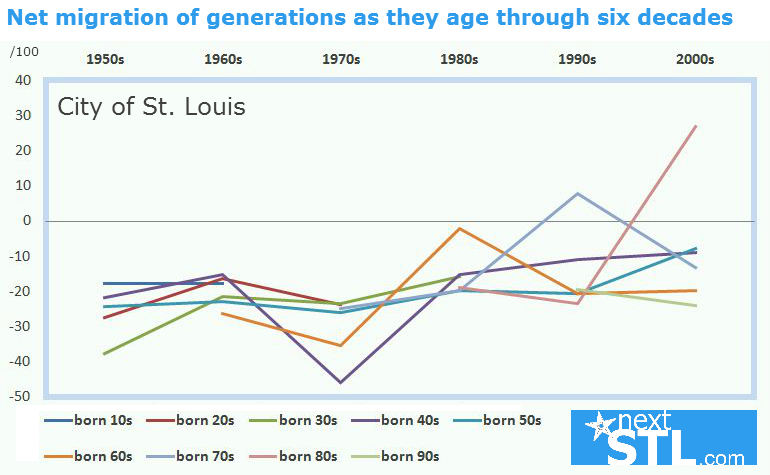
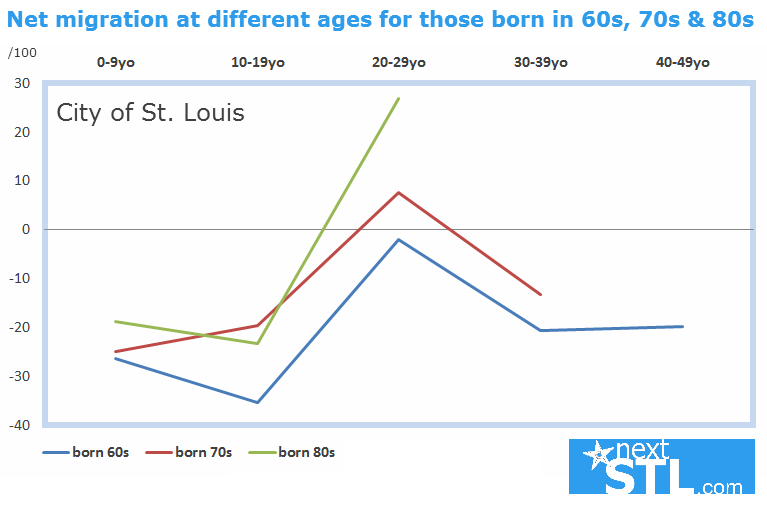
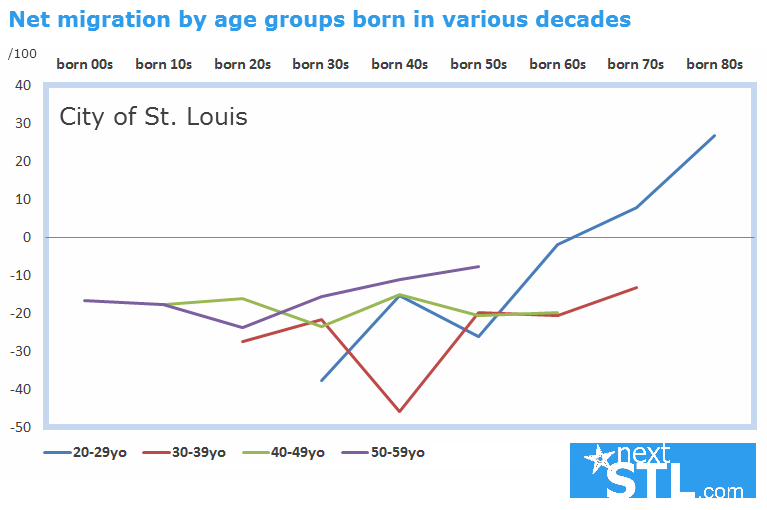
*”Net migration” is the balance of in-migrants minus out-migrants. If no one leaves and no one arrives, net migration equals zero. If 10 residents leave and 10 new residents arrive, net migration is zero. So when net migration for 25 to 29 year-olds was -28.1/100 in the City of St. Louis in the 1970s, it could be that 28 residents of that age group left and zero arrived. Of course the reality is that people of all age groups are moving into the city each year. Net migration is a measure of how many individuals the city has gained each year (arrivals minus departures).
*All data derived from Net Migration Patterns for US Counties, a project of The Applied Population Laboratory at the University of Wisconsin
